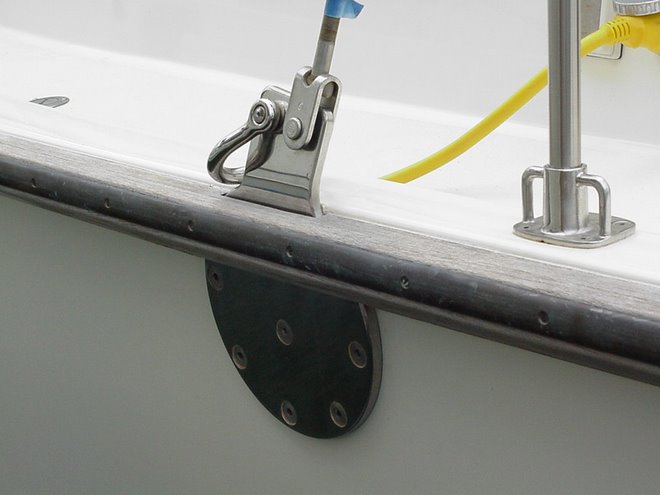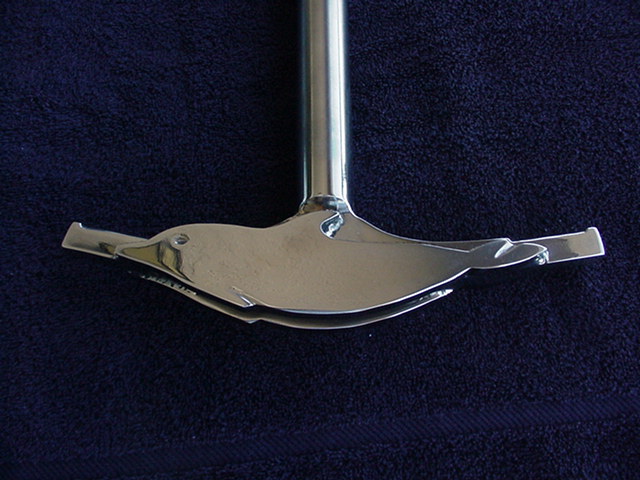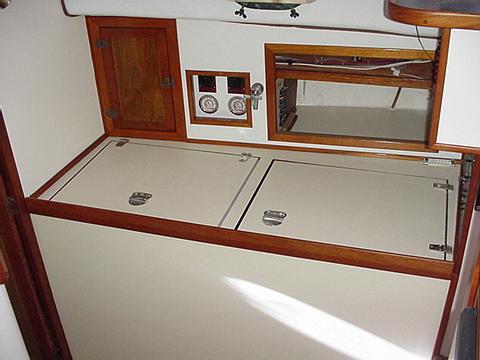A.C. Electric Motor Horsepower, by Kevin S. Brady, Esq.
Sometimes things are written so well, it makes no sense to try to put it in your own words..not that I could! Here then is an article I just read that most DIY mariners might like to read. As a group, we are often trying to figure out how to set something up, like an inverter, inverter/charger, home built watermaker or A.C. refrigeration etc. Here's a good read before you get too far into the project.
The Numbers Game:
A Primer on Single-Phase A.C. Electric Motor Horsepower Ratings
Kevin S. Brady, Esq., Minneapolis, Minnesota
Note: This article is located online at: http://www.kevinsbrady.net/motors.pdf This article may be reproduced and disseminated for educational and personal, non-commercial uses, provided that the copyright notice is not removed and the author is given proper attribution. All other uses are expressly forbidden without the written consent of the author.
DISCLAIMER:
The reader assumes all responsibility and liability associated with the hazards of working with power tools. The author has no control over how a reader will act as a result of obtaining information in this article. The author shall not be responsible for any errors or omissions that may be present in this article. Accordingly, the author shall assume no liability for any action or inaction of a reader.
This article is directed toward a hobbyist audience and is not intended for application in a commercial, institutional, or industrial setting. Commercial shops are generally governed by a complex set of worker safety regulations, such as those mandated by OSHA. Satisfying the compliance of such regulations is beyond the scope of this article.
YOU CAN HANG A SIGN ON A PIG SAYING IT'S A HORSE...BUT IT'S STILL JUST A PIG.
This old saw applies to both animals and advertising alike. And while the distinctions between a pig and a horse should be painfully obvious, attempting to differentiate the true horsepower of an alternating current (A.C.) electric motor from its advertised power is not easily accomplished. No doubt you have noticed a great deal of hype concerning these horsepower claims. Power tools and other shop devices are no exception. Advertising claims, touting huge horsepower ratings in seemingly modest equipment, are commonplace. Just because the ads or the packaging says it, does that make it so? What does this really translate to in regards to power? Let's get to the bottom of it.
DO THE MATH.
Since most people find mathematics to be about as fascinating as watching a guy making a weiner dog out of balloons, I'll keep the calculations simple.
One horsepower (HP) equals 746 watts. If a motor is rated at a true 1HP, that means it delivers 746 watts of mechanical power. Since single-phase motors (the kind usually found in consumer power tools) are never 100% efficient in converting electrical energy to mechanical energy, the amount of electrical power consumed by the motor is considerably higher than the mechanical power delivered. In fact, losses from heat, friction, etc., mean that a typical single-phase motor is, at best, around 60-70% efficient. A figure closer to 60% is more realistic for the small induction motors typically found in many home-shop power tools. That means a genuine 1HP motor requires roughly 1250W or more of electrical power to deliver its rated power. In short, you will need at least 10 amps of current at 125V, or 5-plus amps at 250V to realistically deliver a true one horsepower from your motor. This is a good rule of thumb to keep in mind.
Most portable power tools, and many of the cheaper stationary tools, use universal motors. Unlike induction motors, the speed of which is dependent on A.C. frequency and the number of poles, universal motors are capable of much higher speeds, and variable speeds. Universal motors are generally more 1
compact than induction motors, and are found in circular saws, drills, vacuum cleaners, routers, benchtop planers, etc. Universal motors are typically much noisier than induction motors. Power up a benchtop planer and you will know what I mean. Due to their wide variances in efficiency from one to the next, it is difficult to ascertain the true horsepower of universal motors, though you can still do the math based on voltage and current and determine if the manufacturer's power claims are exaggerated.
Here's how to look at it: The vast majority of 125V consumer electric devices for use in North America are rated to use 15A or less. That's because most 125V household circuits are protected by 15A circuit breakers. Power is the product of voltage and current: volts times amps equals watts. Thus, a 15A 125V outlet is capable of delivering 1875 watts of electrical power to an electrical device (load). This is based on "ideal" conditions, and assumes no voltage drop at the load. But all conductors have a certain amount of electrical resistance, resulting in a voltage drop at the load. Depending on the load resistance, the line conditions, length and diameter of wiring and cord conductors, and other factors, the load voltage is usually somewhat less than the nominal 125V. If we are to use the "ideal" conditions, we take amps times volts to determine watts, so 15A X 125V = 1875W. Factoring a best-case efficiency factor of 70% (multiplying by 0.7) yields 1313W of delivered output power. Convert watts to horsepower: divide 1313 by 746 and you have about 1.76HP, the most continuous power you can achieve from a 15A, 125V motor. If the device is designed to operate on an ordinary 15A 125V outlet, it cannot deliver more than one and three-quarters horsepower.
However, using more realistic conditions, let's assume that our line voltage has dropped to 115V at the load (this is not unusual) and our 15A motor is only 60% efficient. Multiplying amps times volts gives us 15 X 115 = 1725W. Factoring in the motor's 60% efficiency yields a maximum continuous output power of 1035W, or about 1.39HP. Of course, Ohm's Law states that if power remains constant, as voltage decreases, current increases proportionately. But keep in mind that the power typically will not stay constant, and a depressed voltage condition at the load will often result in a decrease in power. In any case, these calculations are approximate, due to such non-linearities.
Thus, our equation for determining motor power (HP) is:
((LOAD VOLTAGE) (RATED LOAD CURRENT) (EFFICIENCY FACTOR)) / 746
Or more simply put, let's plug in a realistic efficiency factor of 60% and a "worst-case" load voltage of 115V to simplify the equation. Horsepower now equals:
(RATED LOAD CURRENT) / 10.8
If your device operates on 250V, and we consider a load voltage of 230V, the horsepower equals:
(RATED LOAD CURRENT) / 5.4
Based on these simple calculations, if the device plugs into an ordinary 125V 15A outlet and the manufacturer is claiming a horsepower rating much greater than 1-1/2 or so, it would appear that they are stretching the truth. Or are they?
IT'S NOT REALLY LYING -- IT'S JUST CREATIVE MARKETING. YEAH, RIGHT.
So if it takes ten or more amps at 125V to achieve one HP, why is it that I can buy a device that says it develops, say, five HP, and still plug it in to my 15 amp wall outlet? Did someone change the Laws of Thermodynamics in the middle of the night and forget to tell me? This is absurd. Can manufacturers make such outlandish claims? Sure they can - they do it all the time. As far as I can tell, they're not really committing consumer fraud under the FTC, they're just skewing the data a bit. It's called puffing, something done everyday in the world of advertising and sales.
2
It's worth noting that there was one rather notorious class action settlement involving misleading horsepower claims made by a number of air compressor manufacturers. Since the case ended in a settlement, and was not adjudicated by a court, the case does not serve as legal precedent. This leaves the legal question of fraud unanswered, allowing manufacturers to continue to engage in similar practices.
Take a trip through any home center store, and you will find an array of motorized tools and other devices, with their respective "horsepower" ratings emblazoned on them. This particularly applies to circular saws, routers, air compressors, and shop-vacuums, the makers of which often attaching wildly exaggerated claims of power. Obviously, "puffing" is still the norm. I have seen models of shop vacuums and air compressors boasting 5HP at 125V! If this were true, you would need a power cord as big around as your thumb to handle the current and an industrial 50-amp outlet to plug it in to! The streetlights on your block would flicker every time you turned it on! Seriously, there is a method to their madness, and it all happens in a miniscule moment of time.
TIMING IS EVERYTHING, AND WITH INFLATED HORSEPOWER CLAIMS, THE MOTOR IS MEASURED IN A SPRINT, NOT A MARATHON.
The underlying truth of what the manufacturer is probably not telling you (or the salesperson simply doesn't know), is that a so-called "five horsepower" device really means that, under very particular conditions, it is capable of developing 5 HP of peak power -- for a very brief interval of time. This is not continuous, full-load power. Note that they might use the term "develops" or "peak" immediately preceding the horsepower figure in the rating claim. Often stated as "develops 5 HP." The peak power of a motor in this situation is calculated by measuring its electrical power consumption at its stall torque, as simulated in a laboratory. A mechanical load such as a braking mechanism is applied to the running motor, which causes the shaft to stop turning. At that precise moment in time, the motor will draw its peak electrical power (kids, don't try this at home). At that point, the motor is suddenly drawing an abnormally high amount of current -- a phenomenon called "locked rotor current," which is similar to inrush current. You may witness this phenomenon when your circular saw momentarily binds up while cutting wet wood (notice how the lights dim when this happens!). The whole concept of peak power is silly, because the motor is not intended to be operated in this condition for more than a brief interval. It is not a practical measurement of the motor's true capabilities. A motor in a device such as a saw is better defined by the power delivered while continuously doing its intended job - cutting wood! Stalling an electric motor for more than a few seconds will cause it to heat up and possibly burn out, though your circuit breaker will (hopefully) trip first. The motor is, for a very brief moment, drawing much more current than normal. The manufacturers cleverly use this abnormally high electrical current transient to calculate its "peak" horsepower, using the same equation discussed above. This mathematical sleight-of-hand affords the manufacturer some distorted bragging rights as to power.
This touted value based on stall torque becomes even more outlandish when you consider the fact that when the motor is stalled (shaft not turning) it is not delivering any power. Power is force (torque) times velocity - thus force times zero equals zero!
As discussed already, the true measure of a motor is its continuous power. This is where the rubber hits the road. If you still doubt this, visit a reputable electric or industrial supply house and look at the bona fide 1HP motors they have on their shelves. On the motor's placard you will likely see an amperage rating of well over 10A at 125V or 5A at 250V! This is amperage based on the motor operating under continuous, full-load conditions.
On the other hand, you will find cheaper motors sold in places like Harbor Freight and Northern Tool & Equipment that are touted as "compressor duty" - a term that is merely another sales gimmick used in the same kinds of exaggerated horsepower claims.
NEVER MIND THE HYPE -- IT'S THE AMPERAGE.
3
How do we sort through this slippery business with electric motors? The best way is to approach the manufacturer's exaggeration with a good dose of skepticism. Fortunately, most motorized products have such a placard or label attached, disclosing the voltage and current (amperage) ratings. Volts multiplied by amps gives you watts, and by dividing this number by about 1250, you can get a good ballpark figure of continuous HP from here. Of course, we can never be absolutely sure of the true power, short of measuring the motor with a dynamometer. But since the line voltage usually remains fairly constant, we use the amperage as a rule of thumb. Motor efficiency is still the wildcard, but we can nonetheless use the amperage spec to obtain a good approximation for comparison purposes.
So if you are choosing an electric drill and it's power you are looking for, compare models based on their amperage ratings, and ignore the touted horsepower specs. Don't always believe what the manufacturer or salesperson claims for horsepower. What is passed off for a horse may just be a pig.
HORSEPOWER TO AMPERAGE TABLE:
O.K., now that I've bored you to tears with the math, here is a handy conversion table with rough approximations of input amperage required for common sizes of single-phase induction motors. This table gives a set of amperage requirements, based on efficiencies of 50%, 60% and 70%, with normal load voltages of 115 volts and 230 volts. These values are merely ballpark figures, and are not to be considered absolute limits. If you know your motor's efficiency, and it is near one of these percentages, you can make a rough approximation. Of course, if the motor is made by a reputable manufacturer, the placard will show the amperage, horsepower, etc., and you won't need this table anyway.
Note that the amperage values given below for the larger motors would be quite impractical at 115V (circuits at this voltage are usually limited to 20A). I placed those values on the chart simply to illustrate that a motor claiming that amount of horsepower at 110V-125V is likely a gross exaggeration, which has been the whole point of this article. In fact, getting a full 2 horsepower at 110V-125V is a bit of a stretch, unless it is very efficient. As such, you won't likely find a motor at or above true 2 HP that is designed for use at 110-125 volts. Generally, you will discover that 110V-125V motors (this includes "dual-voltage" motors) will realistically be limited to 1-1/2 HP or less.
Also keep in mind that some cheaper devices may use shaded pole motors, which are much less efficient than induction motors, often as low as 20%. However, shaded pole motors are typically only found in applications requiring low torque and low power (~1/4 horsepower or less). They are commonly used in household fans, toys, cheap tools, etc. Many other tools, particularly hand-held power tools such as drills and circular saws, use universal motors, discussed above.
Horsepower to amperage:
True Horsepower
(Induction Motor)
Amperage at 115VAC:
50% / 60% / 70% Efficiencies
Amperage at 230VAC:
50% / 60% / 70% Efficiencies
1/4
3.2 / 2.7 / 2.3
1.6 / 1.4 / 1.2
1/3
4.3 / 3.6 /3.1
2.2 / 1.8 / 1.5
1/2
6.5 / 5.4 / 4.6
3.2 / 2.7 / 2.3
2/3
8.6 / 7.2 / 6.2
4.3 / 3.6 / 3.1
3/4
9.7 / 8.1 / 6.0
4.9 / 4.1 / 3.5
1
13.0 / 10.8 / 9.3
6.5 / 5.4 / 4.6
1 1/4
16.2 / 13.5 / 11.6
8.1 / 6.8 / 5.8
1 1/2
19.5 / 16.2 / 13.9
9.7 / 8.1 / 7.0
2
25.9 / 21.6 / 18.5
13.0 / 10.8 / 9.3
2 1/2
32.4 / 27.0 / 23.2
16.2 / 13.5 / 11.6
3
38.9 / 32.4 / 27.8
19.5 / 16.2 / 13.9
5
64.9 / 54.1 / 46.3
32.4 / 27.0 / 23.2
4
An example of a true 1 HP motor. Note the ratings of 12.8 amps at 115V and 6.4 amps at 230V. This is the real deal.
Typical sleight-of-hands "peak" horsepower exaggeration on a shop vacuum. Three horsepower you say? Uh-huh.
Placard on the "1/2 HP" motor of a cheap Penn State Industries midi lathe. Note that the amperage rating is suspiciously missing.
ADDITIONAL RESOURCES:
Richard J. Kinch of Truetex Software has a superb article discussing the horsepower and CFM ratings of air compressors. This article covers horsepower calculations based on the compressor's mechanical capabilities. A must-read before you purchase an air compressor. http://truetex.com/aircompressors.htm
FAQ page on the air compressor class-action settlement. http://www.aircompressorsettlement.com/faq.php3
Free calculator software. My free woodworking calculations program, in MS-Excel. Includes (among many other useful functions) a calculator to determine amperage, efficiency, torque and horsepower for single-phase and three-phase A.C. motors. http://www.kevinsbrady.net/free.html
Electric motor FAQ, from rec.woodworking. ftp://ftp.cs.rochester.edu/pub/archives/rec.woodworking/woodwork-motors
Glossary of electric motor terms, courtesy of Rockwell Automation. http://www.reliance.com/prodserv/motgen/b9652new/b9652.htm
Chart of NEMA electrical receptacles, from Pass & Seymour (.pdf format).
http://www.passandseymour.com/whatsnew/pdf/GCMBrochure.pdf
Baldor electric motors. http://www.baldor.com/products/ac_motors.asp
Grainger Industrial Supply. http://www.grainger.com/Grainger/wwg/start.shtml
Voltage Drop Calculator. http://www.stealth316.com/2-wire-resistance.htm
Reliance Electric Motor Formulae. Electrical and mechanical calculations for single-phase and 3-phase motors. http://www.reliance.com/mtr/flaclcmn.htm
The author used to be an electrical engineer many years ago and is currently an attorney practicing in Minneapolis, Minnesota, advising clients in various technology law matters.
http://www.kevinsbrady.net/
http://www.kevinsbrady.com/
http://www.mntechlaw.com/
Copyright 1996-2008 Kevin S. Brady, Esq. All rights reserved.
5











No comments:
Post a Comment